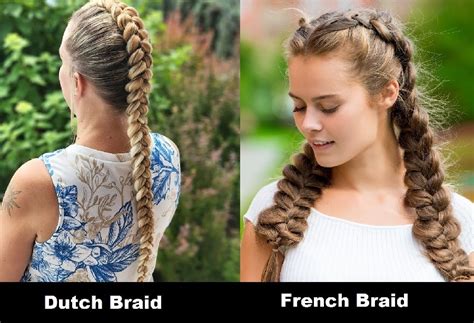Introduction
Braids have been a staple in hairstyling for centuries, adding both beauty and practicality to locks of all types. Among the most popular braiding techniques are Dutch braids and French braids, both of which offer distinct styles and benefits.

Dutch vs. French Braids: A Side-by-Side Comparison
| Feature | Dutch Braid | French Braid |
|---|---|---|
| Strand Placement | Crosses over the center strand | Crosses under the center strand |
| Appearance | Raised, prominent | Flatter, more subtle |
| Volume | Fuller, thicker | More compact, thinner |
| Hold | Tighter, less likely to come apart | Less tight, may loosen over time |
| Suitability | Good for voluminous styles, crowns, and updos | Ideal for intricate braids, fishtails, and headbands |
Dutch Braiding: Step-by-Step Guide
Materials:
- Brush or comb
- Elastic band (optional)
Instructions:
- Brush or comb your hair to remove any tangles.
- Divide your hair into three equal sections.
- Take the right section and cross it over the center section.
- Take the left section and cross it under the new center section.
- Repeat steps 3-4, alternating between the right and left sections.
- As you braid, add small sections of hair from the sides to each section.
- Continue braiding until you reach the end of your hair.
- Secure the braid with an elastic band (optional).
French Braiding: Step-by-Step Guide
Materials:
- Brush or comb
- Elastic band (optional)
Instructions:
- Brush or comb your hair to remove any tangles.
- Divide your hair into three equal sections.
- Take the right section and cross it under the center section.
- Take the left section and cross it under the new center section.
- Repeat steps 3-4, alternating between the right and left sections.
- As you braid, add small sections of hair from the top to each section.
- Continue braiding until you reach the end of your hair.
- Secure the braid with an elastic band (optional).
Benefits of Dutch Braiding
- Creates fuller, more voluminous hairstyles
- Ideal for updos and crowns
- Can disguise thinning hair
- Provides a secure hold for long-lasting styles
Benefits of French Braiding
- Creates intricate, elegant braids
- Suitable for headbands and fishtails
- Can add a touch of sophistication to any style
- Less likely to loosen or come apart than Dutch braids
Differences in Hair Texture and Braiding
The texture of your hair can impact the appearance and hold of your braids.
- Thick hair: Dutch braids will create more volume and texture, while French braids will appear flatter.
- Thin hair: French braids can help add fullness, while Dutch braids may make hair look even thinner.
- Curly hair: Dutch braids can help tame frizz and definition, while French braids may not hold as well.
Creative Applications of Braiding
Braiding techniques can be adapted to a variety of creative applications:
- Halo braids: Create a halo effect by braiding hair around the head.
- Heart braids: Intertwine French braids to form a heart shape.
- Crown braids: Braid hair around the top of the head for a regal look.
- Fishtail braids: Use French braids to create a zig-zag pattern.
Effective Strategies for Braiding
- Section your hair: Divide your hair into equal sections for a balanced braid.
- Add hair as you go: Gradually add small sections of hair as you braid to create a fuller, more secure hold.
- Use hairspray: Apply hairspray before and after braiding to prevent flyaways and keep the braid in place.
- Practice regularly: The more you braid, the better you will become at creating intricate and beautiful styles.
Conclusion
Whether you prefer Dutch braids or French braids, these versatile techniques offer endless possibilities for hairstyling. Understanding the differences between them and adapting them to your own hair texture and needs can help you achieve stunning and long-lasting looks. Embrace the art of braiding and unlock your creativity!
